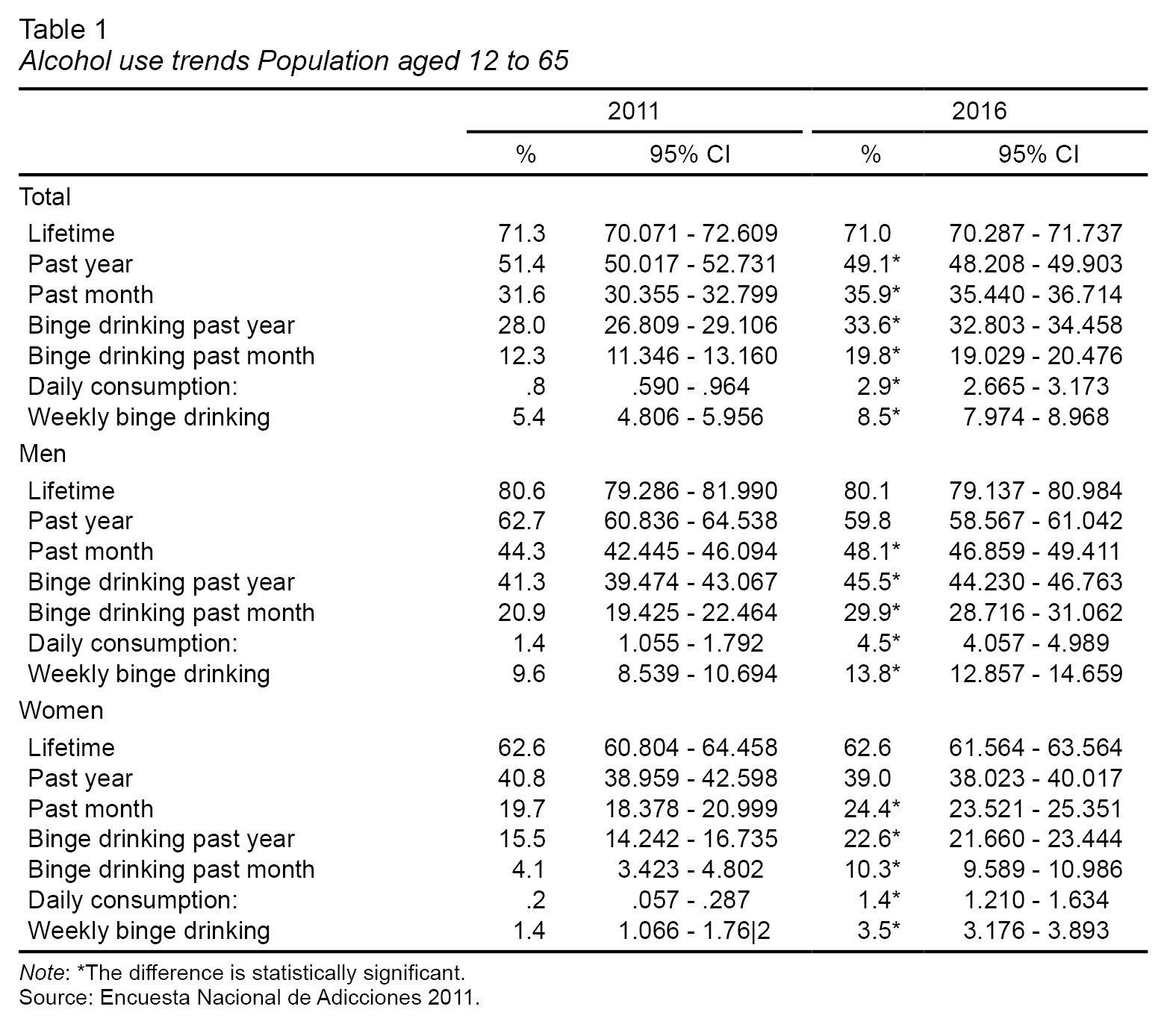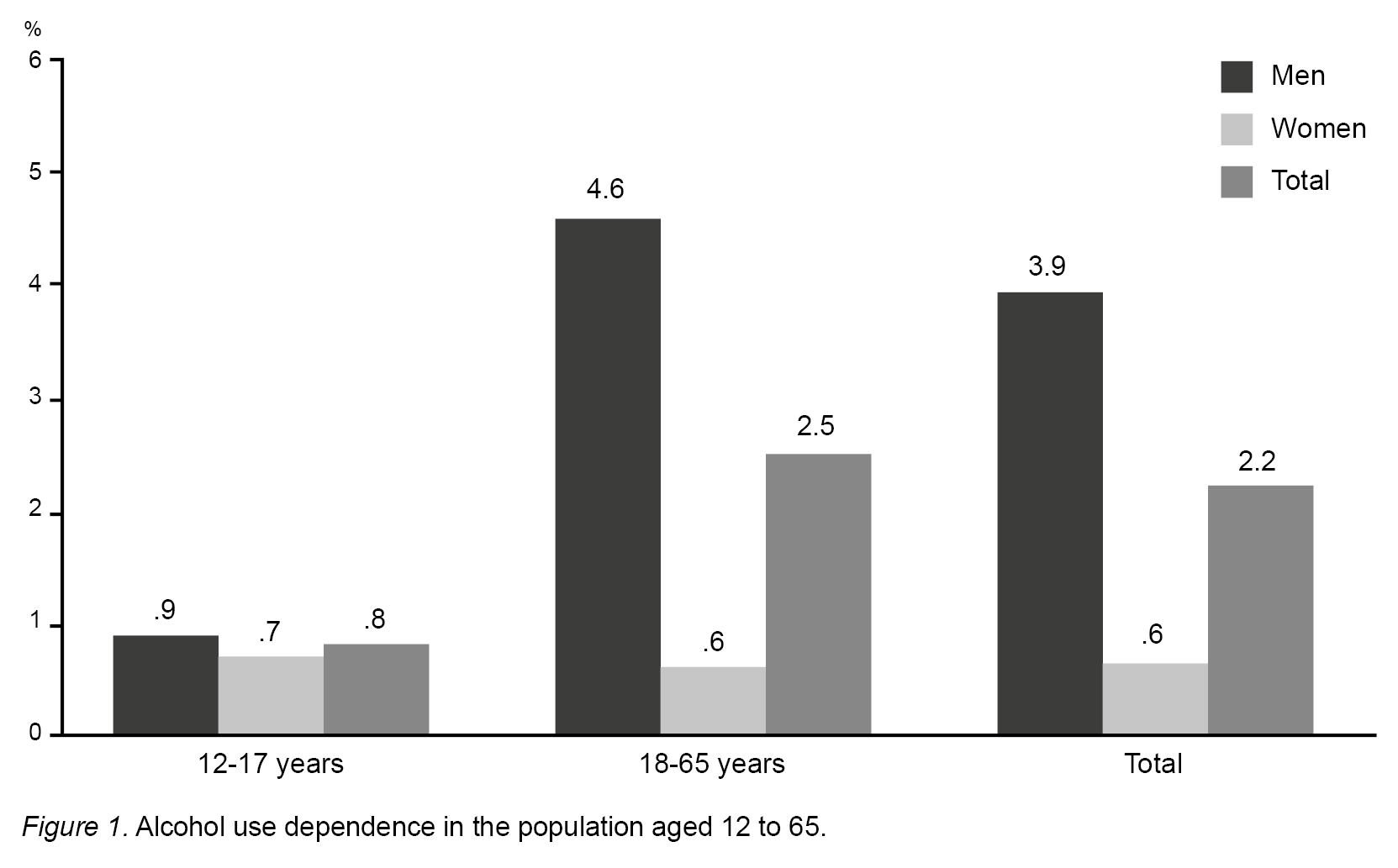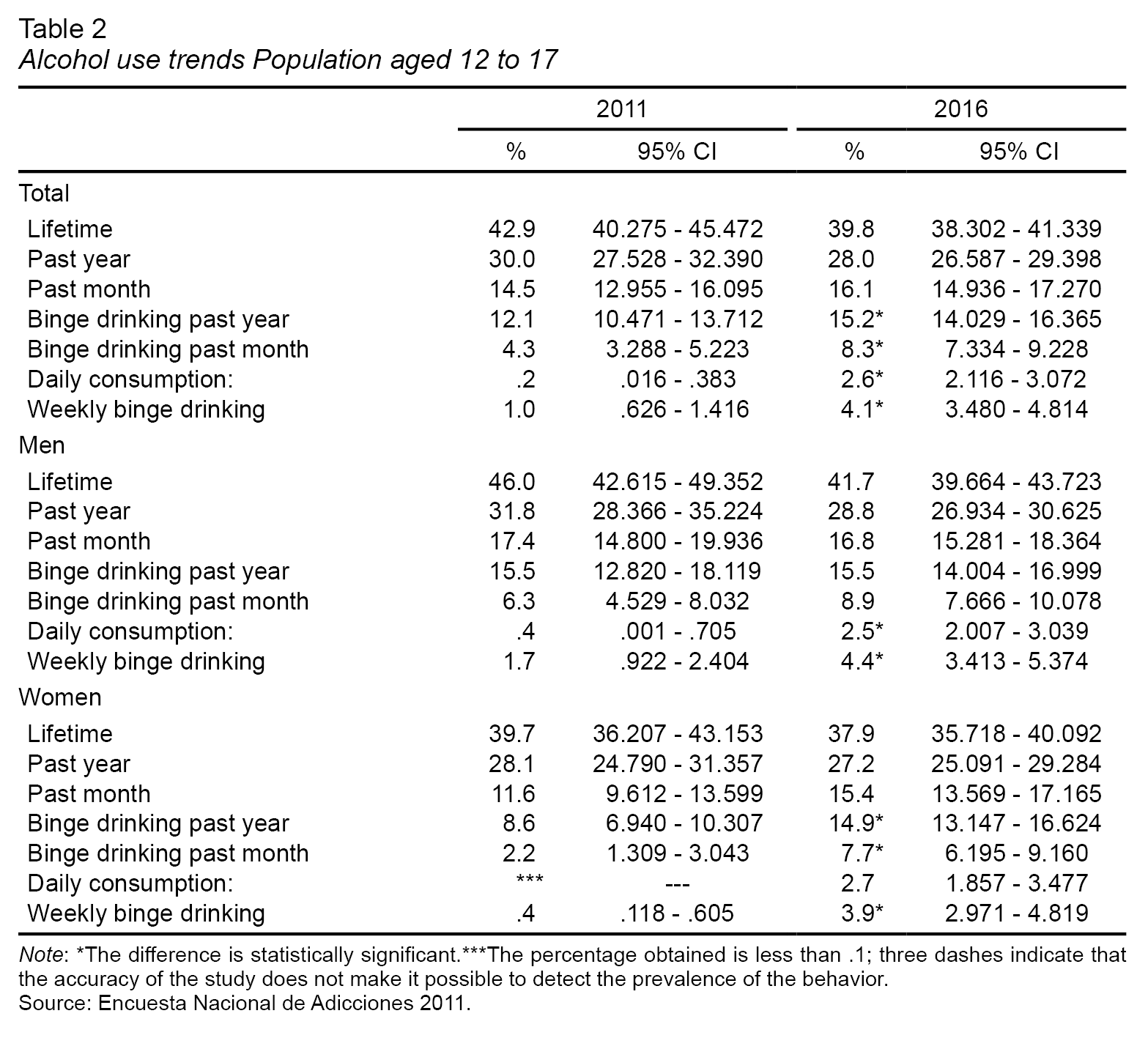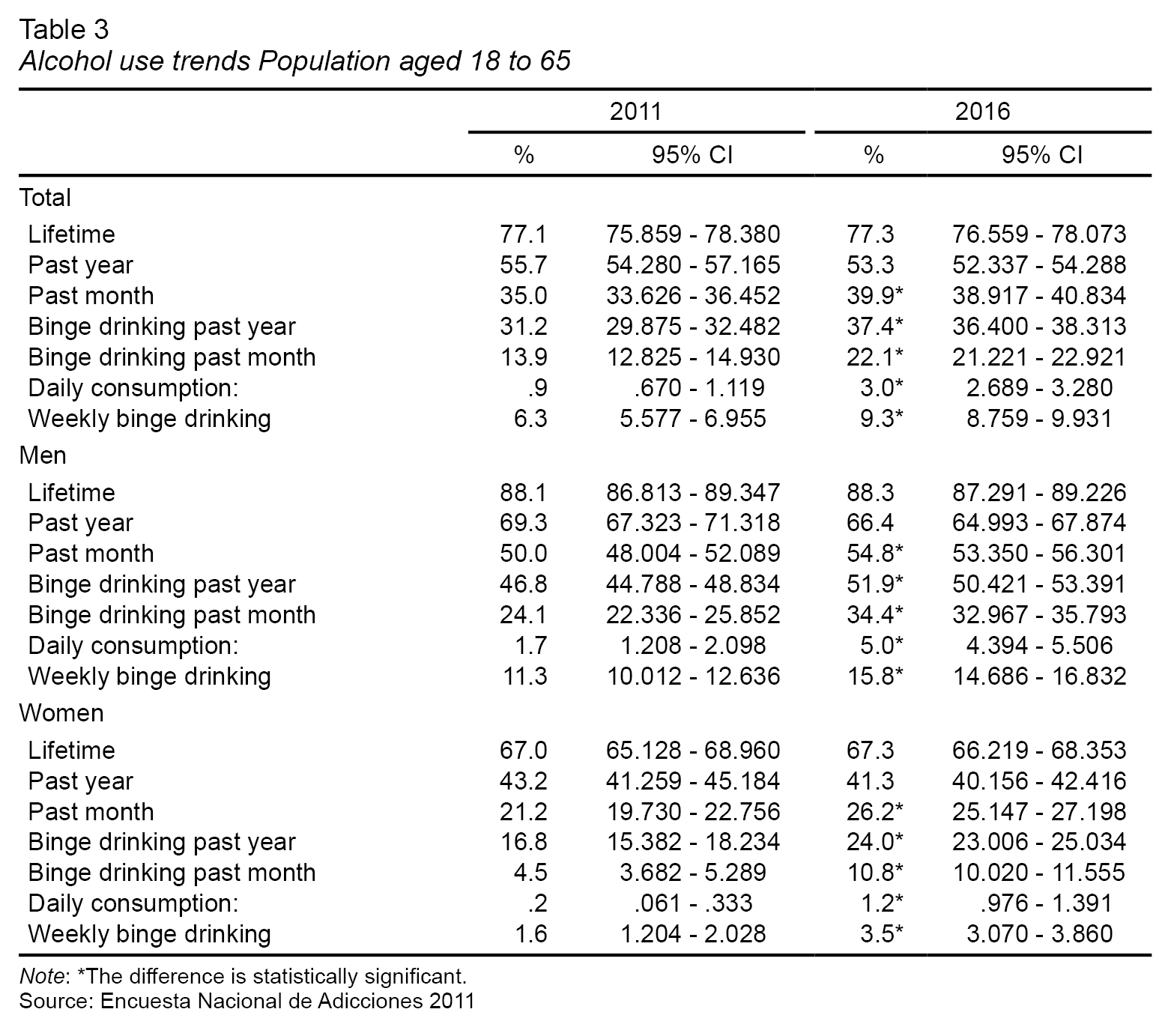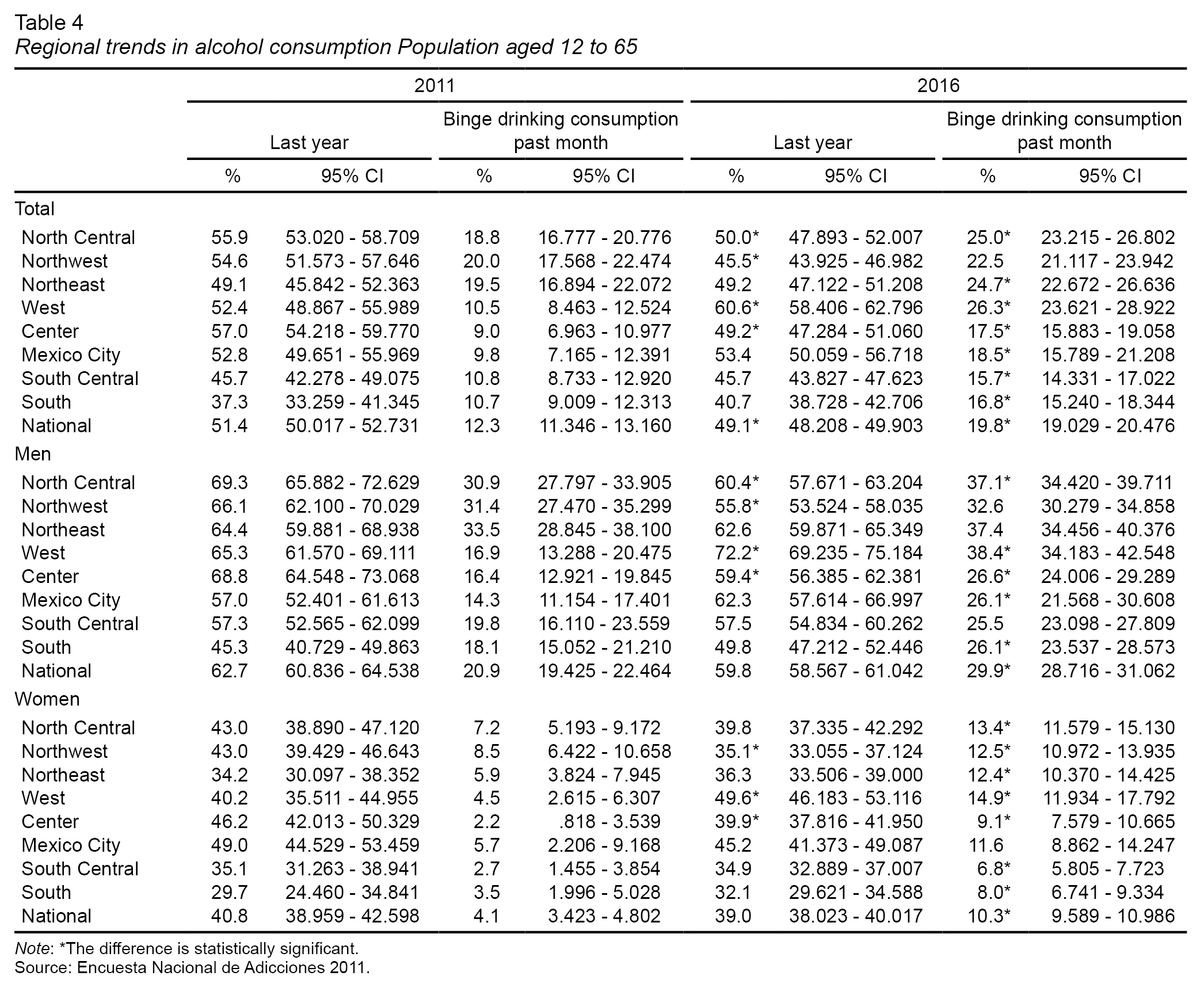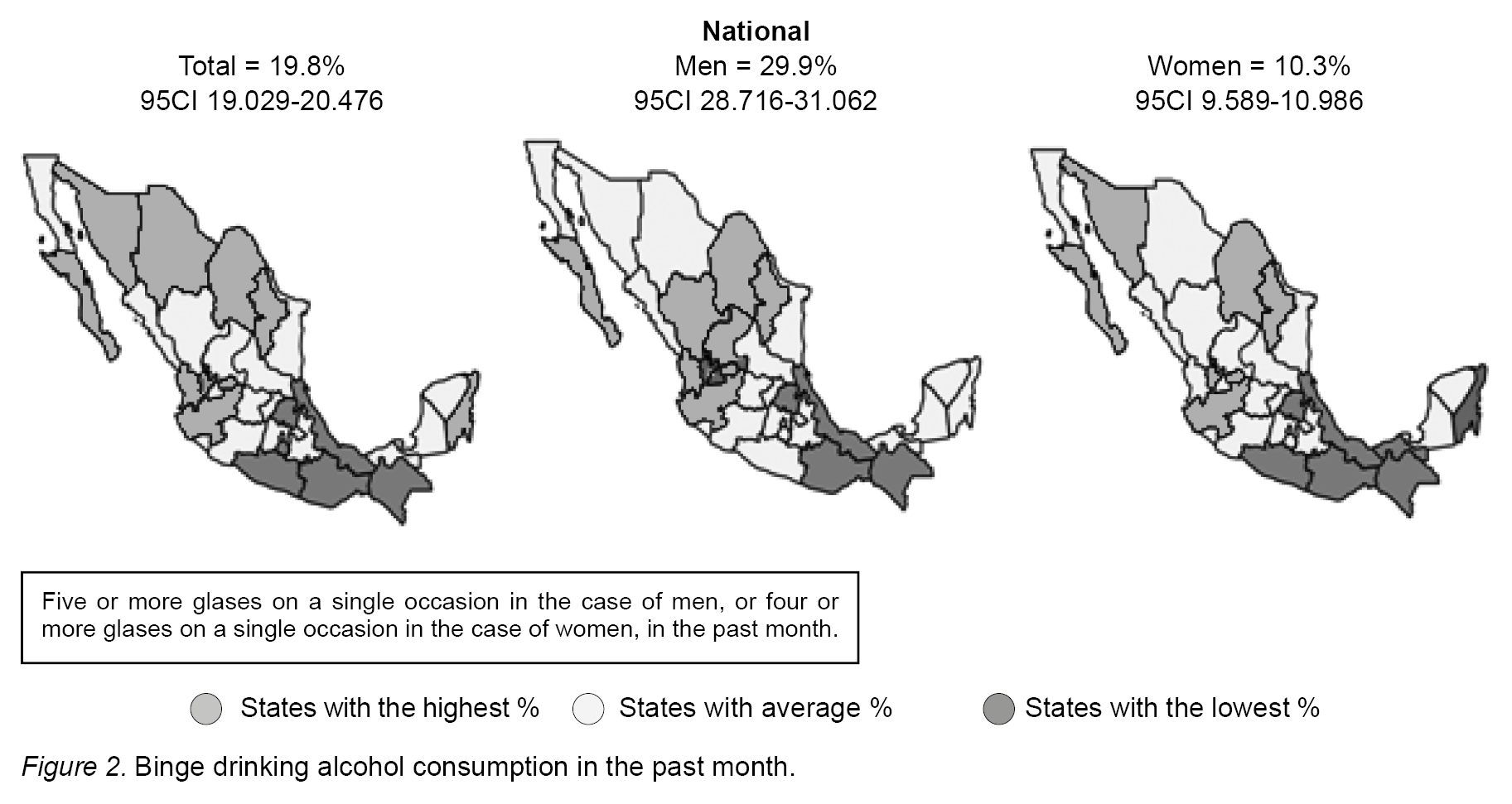Introduction
Alcohol is the substance with the highest levels of use worldwide. The WHO reports that there are 38.3% current consumers aged 15 or over, with the highest percentages being found in Europe and the Americas (66.4% and 61.5%, respectively). Sixteen per cent of users over the age of 15 engage in risky consumption, in other words, they have consumed more than 60 grams of pure alcohol in the past 30 days. In 2010, consumption of 6.2 liters of pure alcohol was recorded in people aged 15 and over, equivalent to 13.5 grams of pure alcohol per day. In Europe and the Americas, the highest per capita levels of alcohol consumption found were 10.9 and 8.4 liters, respectively. Episodes of binge drinking were recorded in 7.5% of the total population (United Nations Office on Drugs and Crime [UNODC], 2017).
In young people aged 15 to 19, consumption rates of this substance amounted to 34.1%. Here, Europe (69.5%), the Americas (52.7%), and the Western Pacific (37.3%) had the highest prevalences of last month use. Binge drinking occurred in 11.7% of the adolescents, with Canada and some European countries reporting percentages of over 30% (UNODC, 2017). Harmful use is among the top five risk factors for disease, disability, and death. In 2012, 5.9% of deaths worldwide (3.3 million) were due to the consumption of this substance (UNODC, 2017).
In the Americas, last year use is between 50% and 60% in countries such as Peru, Venezuela, Barbados, Chile, the Dominican Republic, Colombia, and Bolivia, and less than 50% in Brazil and Suriname. The highest prevalences were registered in Canada (79.8%), Uruguay (74%), and the United States (66.3%) (Inter-American Drug Abuse Control Commission [CICAD], 2015).
Among the student population grades seven to twelve, five South American countries and the Caribbean had percentages of over 75% of ever use, with El Salvador and Venezuela reporting figures of approximately 30%. In Argentina, Colombia, and St. Vincent and the Grenadines, nearly half the students had consumed alcohol in the last month. Within this pattern of consumption, percentages range from 11.5% in El Salvador and up to 50.2% in Colombia. As regards excess last month use, students from South America oscillate between 60% and 70%, whereas in the Caribbean percentages range from 40% to 60%. A key finding of this report is that, as the prevalence of alcohol consumption increases, so does the proportion of students indicating an excessive alcohol use (CICAD, 2015).
Overview of Mexico
In Mexico, alcohol consumption among the population aged 12 to 65 increased between 2002 and 2011. According to the Encuestas Nacionales de Adicciones (ENA) conducted in households, ever using alcohol rates rose from 64.7% to 71.3%, increasing from 35.6% to 42.9% in adolescents, and from 72% to 77.1% in adults aged 18 to 65 (Villatoro et al., 2012). Half the population began consuming alcohol at the age of 17 or younger (55.2%), with men reporting an average age of onset of 16.6 years, and women of 19 years (Villatoro et al., 2012).
According to the ENCODE 2014 (Villatoro et al., 2015), in school population alcohol consumption in middle and high school students is 53.2%, with similar percentages between boys and girls (54% and 52.5%, respectively).
Consumption among middle school students was 40.7% and almost twice as much among high school students (73.9%). At the same time, binge drinking was 14.5% (15.7% boys and 13.3% girls); in middle school it was 8.6%, whereas in high school it was almost thrice higher (24.2%).The beverage of choice is beer, followed by distillates. Among fifth and sixth graders at elementary school, alcohol consumption is observed in 16.9% of the population and is significantly higher among boys (21.5%) than girls (12.1%); 2.4% of these students report binge drinking.
At the same time, at treatment centers, consumers reported alcohol as the main gateway drug (45.8%), 39.3% cited it as the impact drug, in other words, the substance for which they sought treatment, whereas 37.1% of those who attended Primary Care Centers for Addictions (UNEMES-CAPA) did so as a result of their alcohol consumption (Secretaría de Salud, 2016). The Centros de Integración Juvenil report that 86.8% of their users have consumed alcohol at some time in their lives. Alcohol is ranked third among the substances for which users seek treatment (11.5%); the first two being marijuana (41.4%) and methamphetamine (16.1%) (Gutiérrez, 2017a, 2017b).
Of those admitted to hospital emergency service, 67.8% of cases had consumed alcohol. In the Forensic Medical Service, evidence of consumption of some type of substance was found in 8.6% of deaths, with alcohol being the most frequent (66.6%). Among the causes of death under the influence of alcohol, 40% were due to accidents, 34.8% to homicide, 17% to suicide, and 7.7% to non-violent death (Secretaría de Salud, 2016).
A review of the various studies addressing alcohol consumption worldwide and among the Mexican population reveals the patterns of consumption of this substance. These data show that alcohol consumption in Mexico is lower than the average for America and that the predominant pattern is consumption in large quantities leading to episodes of drunkenness.
The last study conducted in Mexico to determine the overall status of alcohol consumption was undertaken five years ago (Villatoro et al., 2012). The fact that the study was representative at a regional level and included teenagers aged 12 to 17 and the population aged 18 to 65 points to the need for current data on the subject and further studies. Given this situation, the objective of this paper is to determine the patterns of alcohol use among the Mexican population aged 12 to 65 from the National Survey of Drug, Alcohol and Tobacco Consumption 2016-2017, together with the state variations taking place in Mexico and to analyze consumption trends in relation to the 2011 survey.
Method
The results reported in this paper form part of the National Survey on Drug, Alcohol and Tobacco Consumption (ENCODAT) 2016-2017, undertaken on population aged 12 to 65 in households in urban and rural communities. Since the survey is designed to make national and state inferences about the prevalence of drug, alcohol, and tobacco use, as well as trends in use in relation to 2011 (Villatoro et al., 2012), the two surveys are comparable.
Population and sample
The survey has a probabilistic, multistage, stratified design, with a confidence level of 90%.The universe selected for the primary sampling units (PSU) comprises the aggregate of AGEBs (Basic Geo-Statistical Areas).A sample size of approximately 1,600 individuals per state was chosen. In each household, wherever possible, an adult aged 18 to 65 and a teenager aged 12 to 17 were selected through simple random sampling in each age group. A response rate of 73.6% was thus obtained. The final sample obtained was 56,877 complete interviews (23,820 men and 33,057 women), of which 12,436 were adolescents and 44,441 adults. Readers are advised to consult the report on the Survey in the methodological section (Villatoro et al., 2017) available on the websites of the participating institutions for a description of the study’s main characteristics (www.inprfm.gob.mx, www.conadic.gob.mx, www.insp.mx).
Definition of variables
Daily consumption: Consumption of at least one glass of a beverage containing alcohol every day.
Binge drinking past month: People who have consumed in the past month five or more drinks on a single occasion in the case of men or four or more drinks on a single occasion in the case of women.
Weekly binge drinking: People who consume once a week five or more drinks on a single occasion in the case of men or four or more drinks on a single occasion in the case of women.
Per capita consumption: Defined as the amount of pure alcohol in liters during a year per inhabitant aged 15 to 65. It includes the consumption of beer, distillates, coolers, prepared drinks, and table wine.
Dependence: Individuals who display three or more of these symptoms are regarded as alcohol-dependent: tolerance, abstinence, use for more time or in larger amounts, persistent desire or inability to control, use of a lot of time to obtain alcohol or to recover from its effects, reduction of social, labor, or recreational activities, as well as continued use despite being aware of its obviously harmful consequences within the 12 months prior to the interview according to the criteria of the Composite International Diagnostic Interview (CIDI).
Health professional: Psychiatrist, GP or family doctor, some other doctor (cardiologist, gynecologist, etc.), psychologist, social worker at a treatment center, nurse, therapist, or other health professional at a health center.
Instruments
The information was obtained through two questionnaires: one for the household and one for the individual. The first was applied to the head of the household, housewife, or another member of the family aged 18 or over who had no difficulty answering and who knew the characteristics of the dwelling and its usual residents. The second was applied to a randomly selected individual, aged between 12 and 17 or 18 and 65 at the time of the visit. It obtained data on sociodemographic information, tobacco, alcohol and medical or illegal drug use, problems related to substance use and personal, social, and interpersonal aspects.
The questionnaire is standardized and has been used in previous studies of this nature. The section on use has been tested by different countries, including Mexico, in conjunction with the World Health Organization and used in student and household surveys since 1974. Through these questions, it is possible to determine global prevalence (ever use), lapsic prevalence (use in the 12 months prior to the survey), and current prevalence (use in the previous 30 days).
The 2016-2017 ENCODAT questionnaire was applied through ACASI (self-administered computer interviews) to a sub-sample of people who had ever attended school. The fraction of ACASI questionnaires assigned was different for each section: the alcohol section was applied to 85% of adolescents and 60% of adults. The section was applied face to face for respondents who so requested.
The alcohol section was applied to 100% of the participants. Those who reported that they had consumed a total of 12 or more drinks in their lifetime or that they had consumed five or more drinks on a single occasion, for men, or four or more drinks for women, subsequently answered the alcohol dependence section.
Procedure
In May, 2016, 323 interviewers, supervisors, cartographers, computer assistants and coordinators were trained. The information was collected from June 1st to October 30th, 2016. To this end, the cartographers paid an initial visit to selected towns and blocks to draw maps and make lists of the households in each block to carry out a probabilistic selection of houses and identify risk areas. The interviewers applied the household questionnaire in the selected dwellings and once this stage had been completed, the computer application selected an adult and/or adolescent to answer the individual questionnaire; the supervisors verified each one of the non-response codes in the selected dwellings and among the selected household members. For each selected dwelling, at least four visits were scheduled at different times and on different days, including weekends to increase the likelihood of finding the occupants at home. Field operating personnel were organized into eight routes, each one consisting of one coordinator, two computer assistants, seven supervisors, and four interviewers per supervisor.
Ethical considerations
The survey was approved by the Research and Ethics Committees of the Instituto Nacional de Salud Pública (INSP) and the Instituto Nacional de Psiquiatría Ramón de la Fuente Muñiz (INPRFM). All the participants were read a letter of informed consent and information was gathered on those who agreed to participate. In the case of minors, their parents or guardians were asked for their authorization for their children to participate and if they agreed, they signed a letter of consent; minors’ consent to participate in the study was also sought. In both cases, emphasis was placed on the objectives of the survey, the voluntary nature of the participation, and the confidentiality of the information.
Statistical analysis
In order to obtain the estimates of the prevalence of the study, the statistical programs SPSS 21 and STATA 13 were used. STATA 13 was used to obtain the confidence intervals and to take into account the sample design that includes the definition of the weight, the stratum, and grouping variable to obtain more accurate estimates.
Results
Prevalence of alcohol consumption
Population aged 12 to 65
The prevalence of lifetime using alcohol is similar to that reported in 2011 (71.3% in 2011 and 71% in 2016), while use in the past year registered a significant decrease from 51.4% to 49.1%, and use in the past month increased significantly from 31.6% to 35.9%.When analyzing the data by sex, only use in the past month increased from 44.3% to 48.1% in men and from 19.7% to 24.4% in women.
On the other hand, binge drinking in the last month, daily and weekly binge drinking have increased from 2011 to 2016 from 12.3% to 19.8%, .8% to 2.9%, and 5.4% to 8.5%, respectively. This situation is repeated in men whose binge drinking rose from 20.9% to 29.9%, daily consumption from 1.4% to 4.5%, and weekly binge drinking from 9.6% to 13.8%, whereas in women binge drinking the past month and weekly binge drinking doubled from 4.1% to 10.3% and from 1.4% to 3.5%, while daily use increased sevenfold from .2% to 1.4% (Table 1).
Dependence on alcohol consumption in the past year was reported by 2.2% of the population, with men having a higher prevalence (3.9%) than women (.6%) (Figure 1).
In general, the age of onset of alcohol use remained stable between 2011 and 2016 (17.8 years in 2011 and 17.9 years in 2016). At the same time, the average number of beverages that produce drunkenness among the population that has consumed alcohol in the past year is 8.7 glasses (10.2 glasses for men and 6.3 for women).
Population aged 12 to 17
Among the adolescent population, the prevalences of lifetime use of alcohol (39.8%), past year use (28%), and past month use (16.1%) did not significantly vary with respect to 2011 (42.9%, 30% and 14.5%, respectively). A similar situation occurs when observing the data by sex (ever use of alcohol decreased in men from 46% in 2011 to 41.7% in 2016, whereas last year use fell from 31.8% to 28.8% and past month use declined from 17.4% to 16.8%. In turn, in women lifetime use of alcohol increased from 39.7% to 37.9%, while past year use declined from 28.1% to 27.2%, and past month use rose from 11.6% to 15.4%).
As regards patterns of use, binge drinking use in the last month doubled from 2011 to 2016 (from 4.3% to 8.3%), while daily use increased more than eightfold (from .2% to 2.6%) and weekly binge drinking expanded eightfold (from 1% to 4.1%). The former increased significantly in women from 2.2% to 7.7%; the latter increased in men from .4% to 2.5%, while the third increased in both sexes, from 1.7% to 4.4% in men and from 0.4% to 3.9% in women (Table 2).
Population aged 18 to 65
In the adult population, lifetime use (77.1% in 2011 and 77.3% in 2016) and past year use (55.7% in 2011 and 53.3% in 2016) have remained stable; however, past month use showed a statistically significant increase from 35% to 39.9%.
In relation to binge drinking use in the past month, daily, and weekly binge drinking, prevalence grew significantly from 13.9% to 22.1%, from .9% to 3%, and from 6.3% to 9.3%, respectively. A similar increase was observed in men (binge drinking use from 24.1% to 34.4%, daily use from 1.7% to 5%, and weekly binge drinking from 11.3% to 15.8%) and women (binge drinking use from 4.5% to 10.8%; daily use from .2% to 1.2%, and weekly binge drinking from 1.6% to 3.5%) (Table 3).
Regional trends in alcohol consumption
Alcohol use in the past year only increased with respect to the previous study in the Western region from 52.4% to 60.6%.All regions saw significant increases from 2011 to 2016 in binge drinking past month use, with prevalences ranging from 15.7% in the South-Central region to 26.3% in the Western region, with the exception of the Northwest region, where consumption remained stable (Table 4).
With respect to the population aged 12 to 17 years, the greatest increase in binge drinking consumption occurred in the Western and Central South regions where consumption tripled between 2011 and 2016 (from 5.2% to 15.3% in the Western region and from 2.2% to 7.1% in the South-Central region).
State variations in alcohol use
In 2016, the states with higher prevalences than the national average for lifetime use and last year use were: Jalisco (80% and 63.7%), Colima (78.5% and 57.3%), Nayarit (77.6% and 57.2%), Mexico City (76.6% and 53.4%), and Aguascalientes (76% and 58.8%); while Quintana Roo (55.5%) and Nuevo León (54.8%) had higher prevalences than the national average for past year use.
Regarding daily consumption, Durango has a higher prevalence than the national average (4.4%).This situation is repeated for weekly binge drinking consumption in the states of Nuevo León (16.9%), Coahuila (14.6%), Jalisco (13%), Chihuahua and Durango (12% each), Quintana Roo (11.9%), and Aguascalientes (11.3%). As for binge drinking past month use, the states of Nuevo León (30.3%), Jalisco (27.7%), Coahuila (27.5%), Aguascalientes (26.3%), Baja California Sur (25.8%), Quintana Roo (25.4%), Sonora (24.8%), Chihuahua (23.8%), and Nayarit (23.7%) have the highest prevalences in relation to the national average (Figure 2).
Per capita use in the population aged 15 to 65
Per capita consumption is 4.9 liters of pure alcohol, with men consuming more (7.9 liters) than women (2.1 liters); while the population aged 18 to 29 years has the highest per capita consumption (7.6 liters) (Table 5). The states with the highest consumption per capita are Aguascalientes (8 liters), Jalisco (7.9 liters) and, Nuevo León (7.4 liters).
Treatment
A total of 2.2% of the alcohol users have sought treatment in the past year for their alcohol use (men 3.2% and women .5%); while 13.9% of the users have experienced dependence in the past year (14.9% of men and 8.1% of women).
More than a quarter of the users with dependence in the past year have been admitted to an anexo (public rehabilitation center) (32.4%), followed by detoxification treatment (24.8%) and psychiatric or residential treatment centers (13.2%).
Lastly, 22.5% of the people who saw a health professional and used alcohol in the past year completed their treatment with a health professional.
Discussion and conclusion
The results of the 2016-2017 National Survey on Drug, Alcohol and Tobacco Use show that alcohol consumption in the country has increased over the past five years, especially in the cases of binge drinking and weekly binge drinking. These increases not only occur among the adult population, but also in adolescents, particularly girls, who report similar levels of use to boys, which also corresponds to a pattern of growth like that observed in Latin America (Pan-American Health Organization, 2015; CICAD, 2015).
The high number of offers and acceptance of the use of this substance may partly explain the growth of consumption in this population. Schools should obviously continue to be monitored, together with alcohol outlets, to prevent the risks associated with binge drinking in adolescents and the sale of alcohol to minors.
In the states where the highest prevalences of binge drinking occur (Nuevo León, Jalisco, Coahuila, Aguascalientes, Baja California Sur, Quintana Roo, Sonora, Chihuahua, and Nayarit), efforts should focus on evidence-based prevention actions in order to reduce consumption, some of which already exist in Mexico (Castro, Llanes, Amador, Villatoro, & Medina-Mora, 2015).
In this study, treatment attendance results show that only a small proportion of people with dependence seek treatment and also that women are the least likely to request help. There is therefore a need to identify the obstacles that cause people not to seek treatment, particularly women, since when they do so, they prefer individual than group treatments. This may be due to the stigma and harassment they experience.
Although prevalences indicate that Mexico has average levels of consumption for Latin America (PAHO, 2015), its results for alcohol in general are high, particularly for binge drinking. It is therefore essential to focus more efforts on creating spaces for those who need specialized care, which should be tailored to their specific consumption needs, gender condition, and proximity to their place of residence.
Likewise, it is necessary to reinforce prevention actions targeting consumers and the people around them, and to focus on the prohibition of the sale of alcohol to minors and on designing public policies, where much remains to be done. Among other elements, these are vital for having better actions and healthy options for our population.
Finally, probabilistic surveys are studies that provide relevant information and serve as an important radiography of the problem under study, although they have the usual limitations of a cross-sectional study, meaning that the conclusions have restrictions regarding possible causality, and this study undoubtedly has these limitations. Likewise, it is always preferable to have larger samples. Nationwide, the study has a more than adequate sample, yet state sample sizes could be increasedin order to improve accuracy, particularly of the indicators with values under 2%. On the basis of the contents of the previous paragraph, the information presented here has been processed in such a way as to provide an objective overview of alcohol use in the country.
